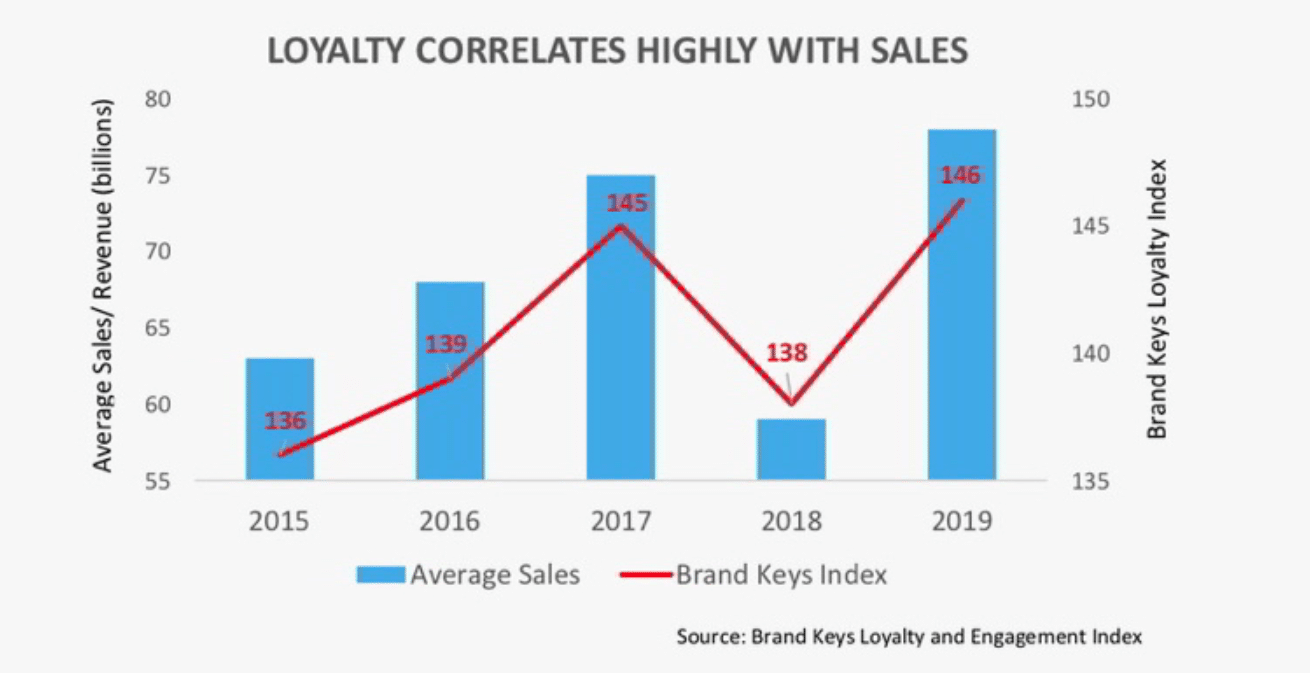With everything from customer-service shortfalls to political posturing taking a toll on consumer opinions these days, establishing loyalty has become one of the most elusive challenges for brands. New research from loyalty and customer engagement form Brand Keys examines brands in 110 categories, providing a unique set of data on loyalty, emotional engagement and brand communications—identifying the most diverse inventory of Top 100 brands as loyalty leaders in over a decade.
“Brand loyalty data predicts business outcomes with exceptionally high correlations to traffic, sales, and associated KPIs,” said Robert Passikoff, Brand Keys founder and president, in a news release. “After years of near total digital brand domination, the Automotive, Restaurant, and Retail sectors have made loyalty gains and now make up half of the 2019 Top 20.”
In addition to fostering higher loyalty levels, brands in those categories have kept customers buying, attracted new consumers, and driven sales to new highs by co-opting techniques that made digital media so powerfully engaging.

2019 Top 20 Brand Keys Loyalty Leaders
(numbers in parentheses indicate last year’s loyalty ranking):
- Amazon: online retail (#1)
- Google: search engines (#2)
- Samsung: smartphones (#6)
- Amazon: tablets (#9)
- Apple: tablets (#7)
- Netflix: video streaming (#4)
- Amazon: video streaming (#5)
- Apple: smartphones (#3)
- Trader Joe’s: natural food retail (#10)
- Hyundai: automotive (#14)
- Twitter: social networking (#23)
- WhatsApp: instant messaging (#11)
- Chick-fil-A: casual/fast-casual (#24)
- Dunkin’: out-of-home coffee (#19)
- Domino’s: pizza (#12)
- Ford: automotive (#15)
- Nike: athletic footwear (#18)
- Discover: credit cards (#26)
- Avis: car rental (#21)
- Toyota: automotive (#22)
Engagement + New Media GPS Platform = Most Accurate Loyalty Metrics Available
This year, Brand Keys merged its independently validated emotional engagement metrics with an entirely new platform, Media GPS analytics, which combines brand communication consumption and engagement to help brands optimize loyalty and media choice. “The combination makes this year’s loyalty assessments the most accurate available to the marketing world,” according to Passikoff.
In the same way that traditional GPS provides accurate determination of geographical locations, Media GPS, developed by Brand Keys and employed in The Advertising Research Foundation’s seminal “How Advertising Works Today” initiative, pinpoints the strategic intersection of brand engagement and media consumption. Adding Media GPS allows brands to identify precisely where and how they should amplify engagement and loyalty along the path-to-purchase via marketing communication efforts with the help of advanced tools like GPS tracking software to monitor and optimize their strategies effectively.
How Consumers Use Media Platforms Shapes Loyalty
Media GPS analysis identifies which loyalty drivers—sets of category specific drivers that exist for every category; e.g., values that define how consumers view a category, compare brands, and buy in a category, will be most influenced by one medium versus another. Additionally, the metrics provide the percentage contribution that each media platform makes to generating awareness, enhancing recall, brand engagement and, ultimately, sales.
“These insights supercharge the already high-correlation-to-sales loyalty metrics (0.80+) and provide more robust media-to-loyalty insights,” said Passikoff. “The addition of brand messaging consumption measures enables brands to develop activation strategies that correlate with sales, enable better deployment of resources, optimizes outreach.”
The 2019 survey examined 26 media platforms for strategic allocation of marketing resources and accommodates drill-down into specific venues. The media platforms include: television, newspapers, B2B publications, OTT, radio, and out-of-home; digital include: mobile, social, apps, and search identifying where and to what extent—one media platform will be more efficient than others, based on consumers’ actual exposure to brand advertising and marketing.
Loyalty Winners
Brands that exhibited the largest loyalty leaps this year included Old Navy (+23), Sam’s Club (+16), Spotify (+15), Twitter (+12), Chick-fil-A (+11), MSNBC (+11), FOX (+10), Kia (+10), Discover (+8), and Samsung (+8).
Loyalty Losers
The brands with the greatest loyalty erosion, affecting their ranks in the Top 100, included iTunes (-27), Uber (-26), YouTube (-22), Under Armour (-21), Facebook (-16), Ketel One (-16), Tito’s (-16), Line (-11), Panera (-11), and Nissan (9).
Loyalty Predicts Sales
“Loyalty is a predictive leading-indicator of future consumer behavior,” said Passikoff. “The more engaged the consumer, the more positively consumers behave regarding purchase, repurchase, and brand recommendation. Numerous surveys have proven loyalty is a predictive indicator of a brand’s future success, usually appearing 12 to 18 months before traditional brand tracking or focus group reports.
“When it comes to loyalty, no matter the category or audience, brands that understand emotional connections can serve as surrogates for added-value and always out-perform the competition,” noted Passikoff. “Brands that make loyalty and emotional engagement a strategic priority always appear high on the Loyalty Leaders List, and more importantly, always appear atop consumers’ shopping lists.”
Unlike economic use models, the Brand Keys’ rankings are 100% consumer-driven, measuring real-time emotional andrational aspects of the consumer’s decision process. The addition of the Media GPS analysis adds media consumption and influence to the calculations. Both sets of analytics have been independently validated as predictive indicators of brand and corporate profitability.
“The good news is loyalty and engagement can be quantified, predicted, and integrated into a brand’s research efforts,” said Passikoff. “The best news is real loyalty metrics correlate highly with customer activity in the marketplace, sales, and profitability.”
See the complete 2019 Top 100 Loyalty Leaders List here.
Brand Keys’ Loyalty Leaders analysis was conducted in August 2019, and included 55,115 assessments (M/F, 16 to 65 YOA, recruited from the nine US Census Regions). Respondents self-selected categories in which they are consumers and assessed brands for which they are customers. The 2019 Loyalty Leader survey assessed 110 categories and 921 brands.



